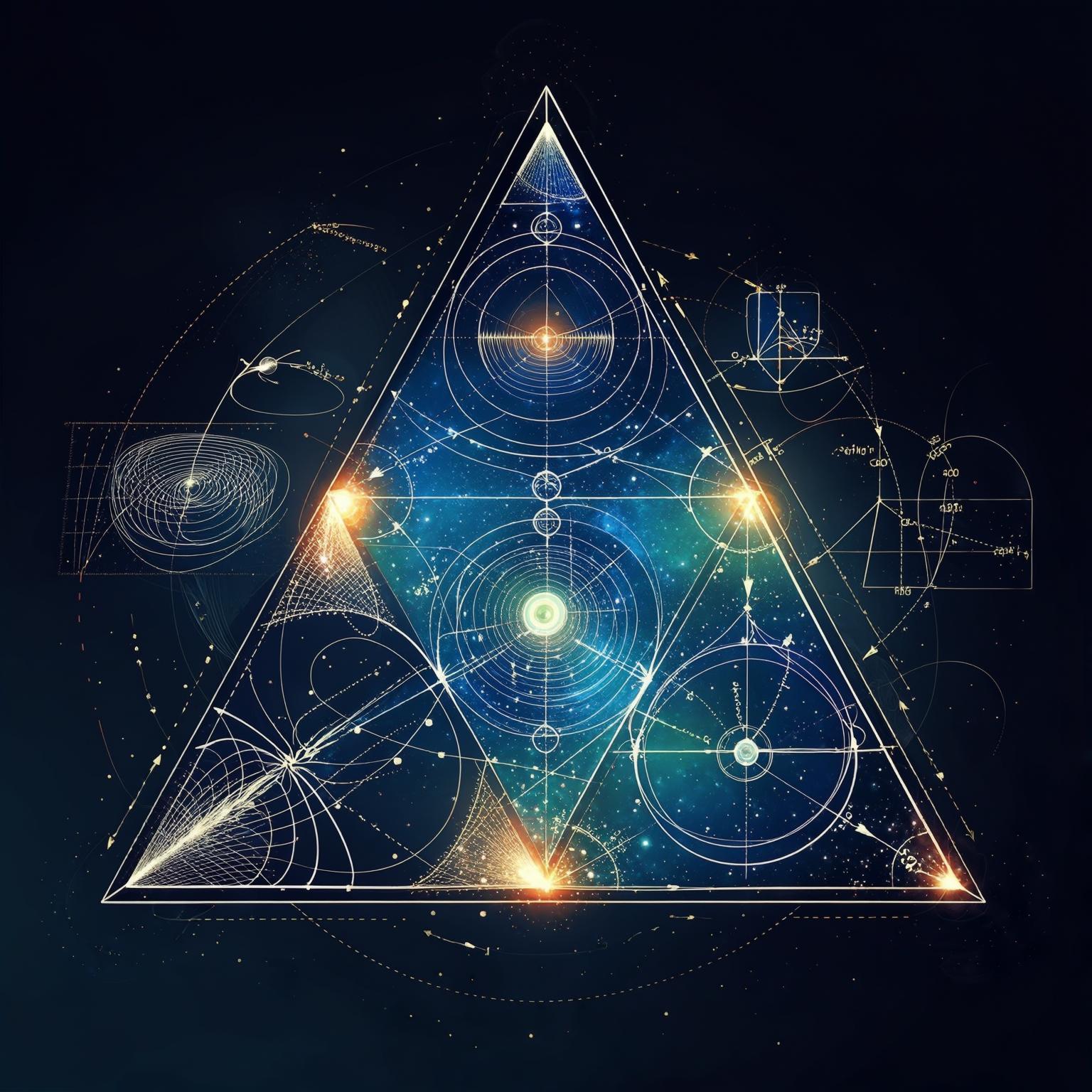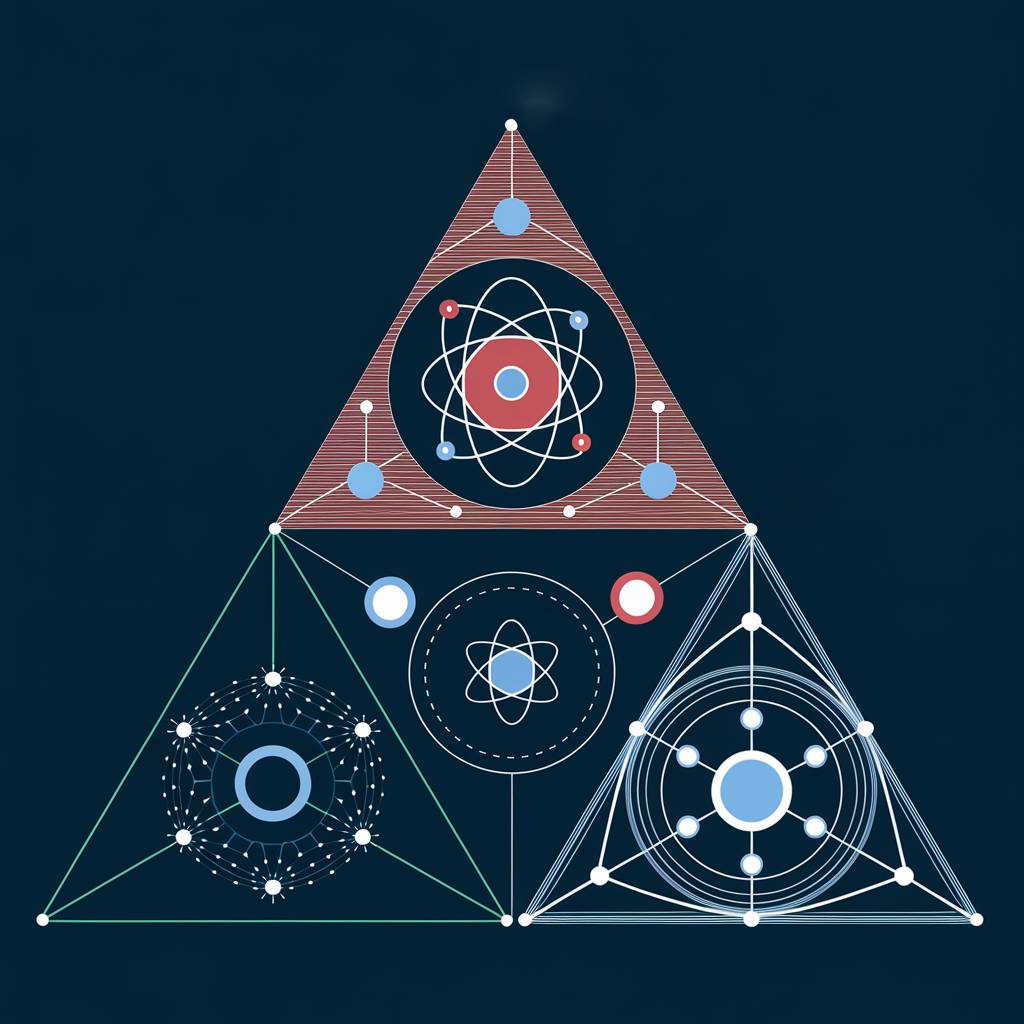Title: Triangular Patterns in Quantum Physics
Author: Alloya Huckfield
Description: Explore the fundamental triangular relationships in quantum physics - from proton-neutron-electron balance to Feynman diagrams. Discover how triangular patterns emerge as a universal organizational principle across scales of physical reality.
tags:
- atomic
- Quantum
- Feynman
icon: LiAsterisktriangular-patterns-in-quantum-and-classical-physics
The triangle serves as a powerful geometric symbol with significant manifestations across various domains of physical reality. Its appearance in quantum physics and fundamental physical forces reveals deeper patterns in the universe's organization.

At the quantum level, atoms display a remarkable triangular relationship among their three main constituents. Protons carry positive charge, neutrons remain electrically neutral, and electrons bear negative charge. These three particle types create a balanced system that enables the formation of stable atoms:
Protons and neutrons cluster in the nucleus, bound by the strong nuclear force. Their similar masses (approximately 1.67 × 10^-27 kg) contrast with the much lighter electron (about 9.11 × 10^-31 kg). This mass relationship creates a natural hierarchy where the heavy particles form a central core while the lighter electrons orbit at a distance.
The balanced charges between protons and electrons establish electrical neutrality in atoms, allowing for complex chemical bonding and the formation of molecules. This triangular relationship between the three fundamental particles creates a system where each component plays an essential and distinct role in atomic structure.
Even more intriguing is how these three particle types correlate with three fundamental quantum properties: charge, spin, and mass. Each particle possesses a unique combination of these attributes, forming another conceptual triangle that defines their behaviour and interactions.
In classical physics, three fundamental forces were historically recognized as governing physical interactions:
Gravity operates on the macroscopic scale, creating attraction between masses that shapes the movement of celestial bodies and everyday objects alike. This force follows an inverse square law, where its strength diminishes with the square of the distance between objects.
Magnetism manifests in certain materials as the ability to attract or repel other magnetic substances. Natural magnets like lodestone demonstrated this force, which creates fields extending beyond the physical boundaries of magnetic objects.
Electromagnetism encompasses electrical forces and their relationship to magnetism. The discovery that moving electrical charges create magnetic fields, and changing magnetic fields generate electrical currents, revealed the profound connection between these seemingly distinct phenomena.
These three forces formed a conceptual triangle in classical physics, providing explanations for most observed physical interactions. Each force operated according to its own principles yet participated in a larger triangular framework of physical law.
Contemporary physics has expanded and refined this triangular model of fundamental forces. We now recognize four fundamental forces: gravity, electromagnetism, the strong nuclear force, and the weak nuclear force. The electromagnetic and weak forces have been unified through electroweak theory, suggesting a progression toward potentially greater unification.
Similarly, our understanding of subatomic particles has grown significantly beyond the proton-neutron-electron triangle. The Standard Model includes quarks, leptons, and bosons—forming a more complex framework that nonetheless exhibits triangular patterns in its organization. For instance, quarks and leptons each come in three generations or families, creating another triangular structure within particle physics.
Even more fascinating is the role of triangular symmetry in quantum field theory, where triangle diagrams (Feynman diagrams) represent fundamental interactions between particles. These mathematical representations reveal how triangular patterns emerge naturally in the mathematical language used to describe quantum interactions.
The recurring appearance of triangular arrangements across different scales of physical reality suggests several important insights:
The triangle represents a minimal stable structure in both physical and conceptual space. With three points, it creates the simplest polygon and the most basic stable framework. This stability principle manifests across scales from quantum particles to cosmic forces.
Triangular patterns enable complex systems to emerge from simpler components. The interactions between three entities create enough complexity to generate rich behaviors while maintaining coherence and analyzability.

The prevalence of triangular patterns may reflect deeper mathematical principles underlying reality. Three-fold symmetries appear throughout physics, from crystal structures to particle families, suggesting fundamental organizational principles at work.
These triangular patterns point toward an underlying coherence in the universe's design. The recurrence of similar structural principles across vastly different scales and domains suggests a deep mathematical consistency in how the universe organizes itself.
The appearance of triangular patterns throughout physics raises profound philosophical questions. Are these patterns merely a consequence of human perception and categorization, or do they represent something more fundamental about reality itself?
One perspective suggests these patterns reflect the human mind's tendency to organize information into manageable frameworks. Our cognitive preference for triadic structures might lead us to emphasize triangular patterns that align with our thinking.
Another view proposes that triangular patterns represent inherent properties of reality independent of human observation. The consistent emergence of these patterns across diverse physical systems suggests they may be encoded in the fundamental structure of the universe.
A middle position recognizes that the mathematics we use to describe physical reality naturally produces certain geometric patterns. The triangle's prevalence may reflect both the universe's inherent organization and the mathematical language we've developed to understand it.
The triangle's manifestation across quantum and classical physics reveals a fascinating pattern that bridges scales and domains of physical reality. From the structure of atoms to the organization of fundamental forces, triangular relationships appear as a recurring motif in nature's design.
This geometric consistency suggests that the triangle represents more than a simple human construct—it appears to be a fundamental pattern woven into the fabric of existence itself. The recurrence of triangular arrangements across different physical systems points toward an underlying coherence in how the universe organizes itself, revealing order and pattern in the seemingly infinite complexity of physical reality.
As our understanding of physics continues to evolve, these triangular patterns serve as guideposts, suggesting connections between disparate phenomena and pointing toward deeper unifying principles that may eventually reveal even more profound patterns in the cosmic order.
The universe, in its vast and intricate design, exhibits patterns that repeat across scales, from the quantum to the cosmic. Among these, triangular and hexagonal formations emerge as recurring motifs in the large-scale structures of the cosmos. These geometric patterns are not merely aesthetic curiosities but fundamental expressions of the underlying physics governing the organization of matter and energy. From the distribution of galaxy clusters to the geometry of spacetime itself, triangular and hexagonal symmetries reveal a profound order woven into the fabric of reality.
One of the most striking examples of large-scale geometric patterns is found in the cosmic web, the vast network of galaxies, gas, and dark matter that spans the observable universe. This web-like structure is not random but follows a hierarchical arrangement, with dense clusters of galaxies connected by filaments and separated by vast voids. When viewed on the largest scales, the intersections of these filaments often form triangular or hexagonal nodes, creating a tessellated pattern reminiscent of a cosmic lattice.

Galaxy clusters, the most massive gravitationally bound structures in the universe, also exhibit triangular and hexagonal arrangements. These clusters are not isolated but often form superclusters, which are the largest known structures in the cosmic web. The arrangement of superclusters can resemble a foam-like lattice, with clusters positioned at the vertices of geometric shapes. For instance, the Coma Supercluster and the Hercules Supercluster appear to form part of a larger triangular framework, with galaxies and clusters aligned along the edges of these imaginary shapes. This alignment is not perfect, as the universe is dynamic and influenced by dark energy and other factors, but the underlying tendency toward geometric order is unmistakable.
The study of these large-scale geometric patterns also bridges the gap between cosmology and other disciplines, such as condensed matter physics and materials science. In condensed matter systems, like superconductors or liquid crystals, triangular and hexagonal lattices are common, arising from the interactions of atoms or electrons under certain conditions. The similarities between these microscopic systems and the cosmic web hint at universal principles of organization that transcend scale. This interdisciplinary perspective enriches our understanding of both the cosmos and the fundamental laws of physics.
Philosophically, the recurrence of triangular and hexagonal patterns in the universe invites reflection on the nature of order and chaos. The cosmos is often portrayed as a realm of randomness, yet these geometric structures suggest an underlying harmony. They challenge us to consider whether the universe is inherently mathematical, as proposed by Pythagoras and later thinkers like Galileo, who famously declared that the book of nature is written in the language of mathematics. The appearance of these patterns across scales—from the quantum foam to the cosmic web—lends credence to the idea that mathematics is not just a tool for describing reality but a fundamental aspect of reality itself.
The large-scale structures of the universe, from galaxy clusters to the geometry of spacetime, are adorned with triangular and hexagonal patterns that speak to a deeper order. These formations arise from the interplay of physical laws, symmetries, and the quest for stability and minimal energy. They connect the microscopic with the macroscopic, revealing a universe that is not chaotic but elegantly structured. As we continue to explore the cosmos, these geometric motifs serve as guideposts, pointing toward a unified understanding of reality where simplicity and complexity, order and randomness, are intertwined in the grand design of existence.
